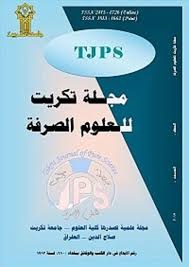Abstract
Three hundred samples were collected from stool, blood
and urine from suspected patients with typhoid fever and
food-poisoning. They collected from mains hospitals of
Mosul City.
Diagnostic were performed using microscopic
examination, biochemical and serological tests, the
results were supported by using API 20E system test, and
then was determined by Salmonella institution in
Baghdad.
Five bacterial isolates of Salmonella typhimurium were
selected depending on source of isolation and irradiated
with the doses of (0.5, 1, 1.5, 2, 2.5, 3, 3.5, 4, 4.5) KGY,
to determine the lethal dose for all S. typhimurium
isolates.
The percentage of antibiotic resistances of
chloramphenicol, Nalidixic acid, Ampicillin,
Trimethoprim, Streptomycin was differing with doses.
After irradiation with the doses (1, 2, 3, 4) KGY the
bacterial colonies that revealed losing their antibiotics
resistance were tested for their demand to growth factors
(Nitrogenous bases and vitamins).
Bacterial colonies showed the needs to the nitrogenous
bases (Thymine, Guanine, Cytosine, and Adenine) and
vitamins (Thiamin, Nicotinic acid).
It have been diagnosis isolated from S. typhimurium
which were lose their resistant for the antibiotics and
other acquired the resistant property for these antibiotics,
also when nitrogenous bases and vitamins were isolate
from minimal medium, colonies lost for their antibiotics
resistant property were appear after the irradiation, this
may be result to generating mutation spontaneous in
some genotypes which is marcing the biological paths
enzymes of growth factors as a result to Gamma rays
effect
